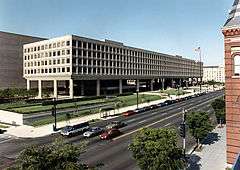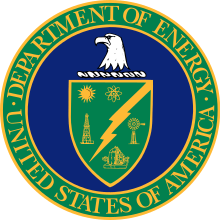Atomic Safety and Licensing Board
|
Seal of the Department of Energy | |
 James Forrestal headquarters complex in Washington, D.C. | |
| Department overview | |
|---|---|
| Formed | August 4, 1977 |
| Preceding agencies |
|
| Employees |
16,000 federal (2009)[1] 93,094 contract (2008) |
| Annual budget | $24.1 billion (2009) |
| Department executives |
|
| Website | energy.gov |
A unit of the United States Nuclear Regulatory Commission authorized under the Atomic Energy Act, the Atomic Safety and Licensing Board Panel consists of administrative law judges who hear complaints similar to ordinary district court except for subject matter jurisdiction which pertains to matters under the Act, specifically, nuclear safety issues pertaining to licensed nuclear power plants. There are in excess of one hundred such plants in the United States, some of which are subject to litigation before the panel.[2]
Scope of authority
Licensing Boards conduct public hearings concerning contested issues that arise in the course of licensing and enforcement. The scope is restricted to nuclear reactors and the civilian use of nuclear materials .[3][4] Jurisdiction is limited to civilian commercial nuclear power reactors, test and research reactors in the United States. Thus, plants owned by US firms or operated by the US government in overseas location, are exempt.[4]
Mandate
The NRC is charged to protect the public health, safety, and the environment. The ASLB does not look to promotion of nuclear or atomic energy as any concern. It differs from "similar federal regulatory or administrative tribunals" in that the three Board judges usually consist of one attorney and two scientific experts.[5] "Individuals who are directly affected by any licensing action involving a facility producing or utilizing nuclear materials can participate in a hearing..."[6]
Current and historic concerns
Matters under adjudication include "early site permits", operating licenses for proposed nuclear reactors, Yucca Mountain, and the contentions [7] of Mothers for Peace with regard to Diablo Canyon Power Plant.[8] In the aftermath of the Fukushima Daiichi nuclear accident, regulatory pressures are expected to increase.[9]
Diablo Canyon Power Plant
DCPP is located in an area proximal to several earthquake faults which have created increasing public anxiety in 2011. As a result,both the operator, Pacific Gas and Electric, anti-nuclear activists, and public officials requested that the litigation before the Board, as well as re-licensing of the plant, to be suspended pending completion of three dimensional seismic studies. This request was granted,[10] with all sides [11] claiming the move as a victory for their respective causes.
See also
- Diablo Canyon Power Plant
- Diablo Canyon earthquake vulnerability
- Mothers for Peace
- Alliance for Nuclear Responsibility
- Nuclear safety
- Nuclear safety in the United States
- Nuclear energy policy in the United States
- Nuclear energy policy in the United States
- United States Department of Energy
- United States Nuclear Regulatory Commission
- Office of Nuclear Reactor Regulation
- Nuclear Regulatory Commission
- Proposed and finalized federal regulations from the United States Department of Energy
- GovEnergy
References
- ↑ (PDF) https://web.archive.org/web/20101106172132/http://www.cfo.doe.gov/cf1-2/2008CR.pdf. Archived from the original (PDF) on November 6, 2010. Retrieved June 30, 2011. Missing or empty
|title=(help) - ↑ "NRC: Atomic Safety and Licensing Board Panel". Nrc.gov. 2012-03-29. Retrieved 2012-05-17.
- ↑ Administrative Procedure Act and the Commission's implementing regulations, set forth at 10 CFR Part 2
- 1 2 "NRC: ASLBP Responsibilities". Nrc.gov. 2012-03-30. Retrieved 2012-05-17.
- ↑ Section 191 of the AEA.
- ↑ "NRC: The Atomic Safety and Licensing Board Panel (NUREG/BR-0249, Revision 3)". Nrc.gov. 2012-03-29. Retrieved 2012-05-17.
- ↑ "2010-08-24 NRC accepts four Contentions from SLOMFP — Mothers For Peace". Mothersforpeace.org. Retrieved 2012-05-17.
- ↑ "Atomic Safety Board Listens to Arguments on Diablo Canyon - KCOY Santa Maria, Santa Barbara, San Luis Obispo - News". Kcoy.com. Retrieved 2012-05-17.
- ↑ ^ Massachusetts Institute of Technology (2011). "The Future of the Nuclear Fuel Cycle". p. xv.
- ↑ http://www.pge.com/includes/docs/pdfs/shared/edusafety/systemworks/dcpp/aslb_delay.pdf
- ↑ "Diablo Canyon Nuclear Power Plant: The WikiBook/Lois Capps action B - Wikibooks, open books for an open world". En.wikibooks.org. Retrieved 2012-05-17.
External links
- The US Nuclear Regulatory Commission supervises the US Nuclear industry
- Nuclear Power Safety and Security Information
